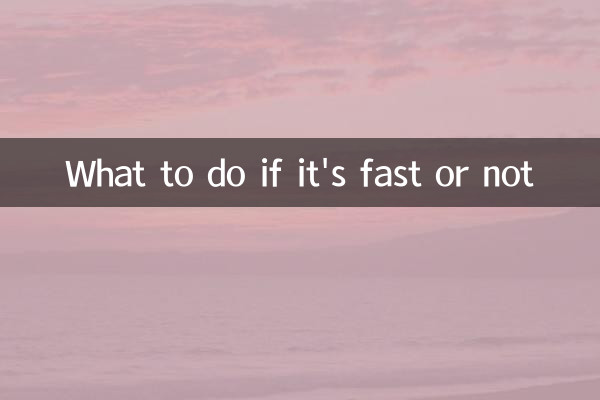What to do if you are not fast: Analysis of hot topics on the entire network in the past 10 days
In the era of information explosion, "fast" seems to have become the standard for modern people, but the subsequent anxiety and inefficiency are becoming increasingly prominent. This article has compiled the hotly discussed topics on "fast" across the Internet for the past 10 days, and uses structured data to analyze the root causes and response strategies of "fast or not" for you.
1. Statistics of popular topics in the past 10 days

| Ranking | Topic Category | Popularity index | Main Platforms |
|---|---|---|---|
| 1 | Workplace intra-volume and efficiency | 9.8 | Weibo/Zhihu |
| 2 | Short video addiction | 9.5 | TikTok/B Station |
| 3 | Fast food reading | 8.7 | WeChat official account |
| 4 | Fast course effect | 8.2 | Xiaohongshu/knowledge payment platform |
| 5 | Fast food culture influence | 7.9 | Douban/Post Bar |
2. Three major problems caused by "fast"
1.Attention fragmentation: Data shows that nearly 65% of netizens focus on average less than 8 minutes, and the average number of video switching times per day for users on short video platforms is as high as 200+ times.
2.Decreased ability to think deeply: A research conducted by a knowledge platform shows that the proportion of readers who can fully read articles above 3,000 words dropped from 42% in 2019 to 18% in 2023.
3.Intensified psychological anxiety: The psychological counseling platform report pointed out that the number of consultations related to "speed anxiety" increased by 120% year-on-year, mainly manifested as:
| Symptom Types | Percentage | Age distribution |
|---|---|---|
| Information FOMO (missing fear) | 43% | 18-30 years old |
| Achievement anxiety | 32% | 25-40 years old |
| Decision fatigue | 25% | All age groups |
3. Five strategies to deal with "fast but not good"
1.Establish an information filtering mechanism: It is recommended to fix 2-3 high-quality information sources every day to avoid being kidnapped by algorithm recommendations.
2.In-depth work training: Try the "Pomodoro Work Method" and gradually extend it from 25 minutes of concentration.
3.Cognitive reconstruction: Recognizing the underlying logic of "slow is fast", important things require time to settle.
4.Technical tool assistance: Use Forest and other focused APPs, and the data shows that the focus time after use increases by 40% on average.
5.Establish reflection habits: Set aside a fixed time every week for systematic review to avoid getting blindly busy.
4. Comparison of response plans for each age group
| Age group | Main issues | Recommended plan | Effective cycle |
|---|---|---|---|
| 18-25 years old | Information overload | Information Fasting Day | 2-4 weeks |
| 26-35 years old | Workplace anxiety | Skills deep cultivation | 3-6 months |
| 36-45 years old | Decreased energy | Time Block Management | 1-3 months |
| Over 45 years old | Adaptation barriers | Progressive adjustment | 6 months+ |
5. Expert advice
Professor Li from the Department of Psychology at Tsinghua University pointed out: "The essence of contemporary people's 'fast anxiety' is time perception disorder, and it is recommended to passMindfulness trainingReconstruct time perception. Data shows that 10 minutes of mindfulness practice every day can significantly improve symptoms of time anxiety after 8 weeks. "
Business consultant Mr. Wang advised: "Business managers should be wary of the 'pseudo-efficiency' trap. Among the companies we serve, the company that implements 'Wednesday' will increase its creative output by 27%.
Conclusion:In this era of speed, learning to "slow down" becomes a scarce ability. Through scientific methods and continuous practice, everyone can find a rhythm that suits them, allowing "fast" to truly serve the improvement of quality of life rather than the source of anxiety.

check the details

check the details